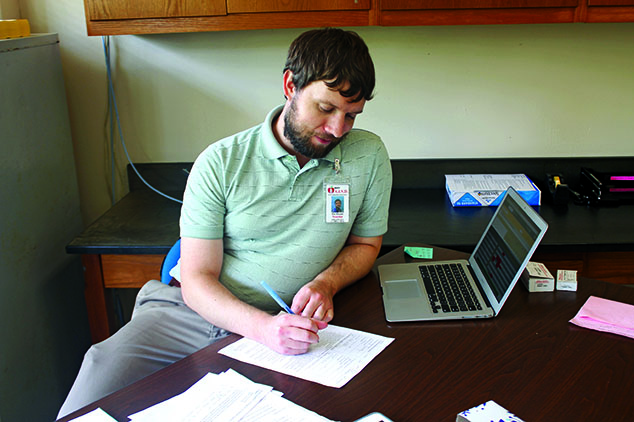From Alaska to Texas: sledding back to warmer weather
New teacher Eric Krauss moved down from the north to teach in his home state
EYES ON THE PAPER: Teacher Eric Krauss grades a students assignment. Krauss made the transition from Kaktovik, Alaska to Austin to teach.
October 2, 2018
Kaktovik, Alaska, is 3265 miles away from Austin, Texas, yet Integrated Physics and Chemistry (IPC) teacher Eric Krauss decided to make the journey there and back twice.
Kaktovik is located is the northeastern part of Alaska and about 298 miles away from the Arctic Circle.
“I lived north of the arctic circle and snow could fall during anytime of the year including the summer,” Krauss said. “Most days there was several feet of snow on the ground and the local roads would have to be plowed daily.”
Life in Alaska brings drastic changes to one’s life, but Krauss was not afraid of the obstacles.
“I wanted a different kind of teaching experience,” Krauss said. “I have lived in Texas most of my life and hanging it up was nice.”
Krauss had lived in Kaktovik for two years and says that his life now in Austin, Texas compared to his life in Kaktovik is more convenient, however he misses the scenery and cold weather.
“It is still weird to me to go to the store and see all the items available at an instant,” Krauss said. “Where I lived, if you didn’t have something you couldn’t get it. You had to order it and wait for it to ship in the mail which took several weeks.”
While in Alaska, Krauss worked as a teacher to several different students at a local school.
“My days were pretty routine, I would go to work and teach 14-20 students per day,” Krauss said. “In addition to teaching all science and math subjects from seventh to 12th grade, I would teach an elective course. Sometimes I would teach PE depending on the semester.”
In Kaktovik, the yearly temperatures differ from around the mid 40s Fahrenheit in the summer down to a high of minus 20 degrees in the winter.
“I remember after my first winter there when the temperature got above zero degrees and how warm it felt outside,” Krauss said. “For the students and people living in the village, zero degrees was warm.”
According to Krauss, the hardest part about living in Kaktovik was flying to Anchorage, Alaska every six months to stock pile up on food.
“The hardest part was shopping for all your food and supplies for six months in two days,” Krauss said. “During that time you had to pack and mail all of it. I would send anywhere from 10 – 20 70 lb totes [of food].”
Flights to Anchorage were long for Krauss and typically were about six hours long with the layovers.
“You would typically fly from Anchorage to Fairbanks,” Krauss said. “Then from Fairbanks to Deadhorse [which is] also know as Prudhoe Bay, then from Deadhorse to Kaktovik. Sometimes you could skip Deadhorse and go from Fairbanks to Kaktovik directly.”
While in Anchorage, Krauss had limited time to buy as much food as he could and never got time to enjoy the city.
“The whole ordeal was stressful, tiring and time consuming,” Krauss said. “I never got to enjoy Anchorage as much as I would have liked because of this.”
Along with flying to Anchorage, Krauss has flown back to Austin, only to endure another long flight.
“Flights back to Texas were long as well,” Krauss said. “Anchorage to Seattle was four hours and it was another four hours from Seattle to San Antonio or Austin.”
Although Krauss has experienced different things in Alaska that he considered normal while living there, he now realizes how different they were and how it will impact his daily routines.
“Life without blizzards that have 100 mph winds and wind chills at -120 degrees will be a significant change to my routine,” Krauss said. “I would frequently encounter polar bears while walking though the village, and I no longer have to worry about that.”
Although Krauss loved his life in Alaska, he had many reasons to move back to Texas.
“I grew up in San Antonio, Texas,” Krauss said. “My wife and I have family here.”
Along with teaching in Alaska, Krauss has taught in many other places in Texas, his home state.
“Before Mr. Krauss taught in Alaska, he taught in Houston and so I think coming back to Texas was interesting to him,” science teacher Erin Kowalik said.
Krauss helps his students by using different ways and methods that he has learned over the years.
“It’s helpful to bring in new people because [Krauss] can make his kids more successful with his new ways to learn,” sophomore Alexis Hertel said.
Bringing in new people to Bowie with different backgrounds, according to fellow teachers, can help the social and cultural environments at the school.
“It’s always wonderful to expand our faculty and get to know new teachers and have them bring their new ideas and teaching styles in to the Bowie High School community.” Kowalik said.










